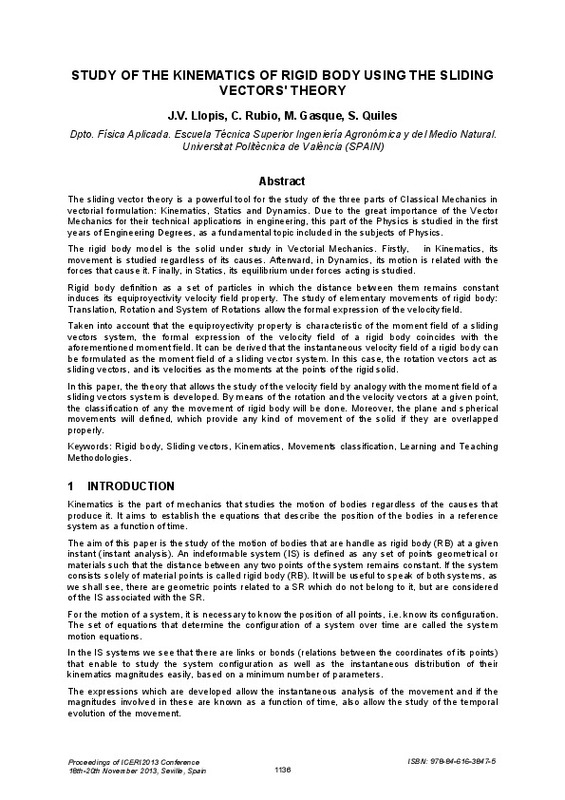JavaScript is disabled for your browser. Some features of this site may not work without it.
Buscar en RiuNet
Listar
Mi cuenta
Estadísticas
Ayuda RiuNet
Admin. UPV
Study of the kinematics of rigid body using the sliding vectors' theory
Mostrar el registro sencillo del ítem
Ficheros en el ítem
| dc.contributor.author | Llopis Cosin, Juan Vicente
|
es_ES |
| dc.contributor.author | Rubio Michavila, Constanza
|
es_ES |
| dc.contributor.author | Gasque Albalate, Maria
|
es_ES |
| dc.contributor.author | Quiles Casado, Susana de la Salud
|
es_ES |
| dc.date.accessioned | 2015-06-09T12:40:47Z | |
| dc.date.available | 2015-06-09T12:40:47Z | |
| dc.date.issued | 2013-11-18 | |
| dc.identifier.isbn | 978-84-616-3847-5 | |
| dc.identifier.issn | 2340-1095 | |
| dc.identifier.uri | http://hdl.handle.net/10251/51426 | |
| dc.description.abstract | [EN] The sliding vector theory is a powerful tool for the study of the three parts of Classical Mechanics in vectorial formulation: Kinematics, Statics and Dynamics. Due to the great importance of the Vector Mechanics for their technical applications in engineering, this part of the Physics is studied in the first years of Engineering Degrees, as a fundamental topic included in the subjects of Physics. The rigid body model is the solid under study in Vectorial Mechanics. Firstly, in Kinematics, its movement is studied regardless of its causes. Afterward, in Dynamics, its motion is related with the forces that cause it. Finally, in Statics, its equilibrium under forces acting is studied. Rigid body definition as a set of particles in which the distance between them remains constant induces its equiproyectivity velocity field property. The study of elementary movements of rigid body: Translation, Rotation and System of Rotations allow the formal expression of the velocity field. Taken into account that the equiproyectivity property is characteristic of the moment field of a sliding vectors system, the formal expression of the velocity field of a rigid body coincides with the aforementioned moment field. It can be derived that the instantaneous velocity field of a rigid body can be formulated as the moment field of a sliding vector system. In this case, the rotation vectors act as sliding vectors, and its velocities as the moments at the points of the rigid solid. In this paper, the theory that allows the study of the velocity field by analogy with the moment field of a sliding vectors system is developed. By means of the rotation and the velocity vectors at a given point, the classification of any the movement of rigid body will be done. Moreover, the plane and spherical movements will defined, which provide any kind of movement of the solid if they are overlapped properly. | es_ES |
| dc.language | Inglés | es_ES |
| dc.publisher | IATED-INT Assoc Technology Education& Development | es_ES |
| dc.relation.ispartof | ICERI2013 Proceedings | es_ES |
| dc.rights | Reserva de todos los derechos | es_ES |
| dc.subject | Rigid body | es_ES |
| dc.subject | Sliding vectors | es_ES |
| dc.subject | Kinematics | es_ES |
| dc.subject | Movements classification | es_ES |
| dc.subject | Learning and Teaching Methodologies | es_ES |
| dc.subject.classification | FISICA APLICADA | es_ES |
| dc.title | Study of the kinematics of rigid body using the sliding vectors' theory | es_ES |
| dc.type | Capítulo de libro | es_ES |
| dc.type | Comunicación en congreso | |
| dc.rights.accessRights | Abierto | es_ES |
| dc.contributor.affiliation | Universitat Politècnica de València. Departamento de Física Aplicada - Departament de Física Aplicada | es_ES |
| dc.description.bibliographicCitation | Llopis Cosin, JV.; Rubio Michavila, C.; Gasque Albalate, M.; Quiles Casado, SDLS. (2013). Study of the kinematics of rigid body using the sliding vectors' theory. En ICERI2013 Proceedings. IATED-INT Assoc Technology Education& Development. 1136-1143. http://hdl.handle.net/10251/51426 | es_ES |
| dc.description.accrualMethod | S | es_ES |
| dc.relation.conferencename | 6th International Conference of Education, Research and Innovation | |
| dc.relation.conferencedate | November 18-20, 2013 | |
| dc.relation.conferenceplace | Sevilla, Spain | |
| dc.relation.publisherversion | http://library.iated.org/view/LLOPIS2013STU | es_ES |
| dc.description.upvformatpinicio | 1136 | es_ES |
| dc.description.upvformatpfin | 1143 | es_ES |
| dc.relation.senia | 252864 |






